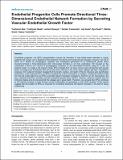| dc.contributor.author | Abe, Yoshinori | |
| dc.contributor.author | Ozaki, Yoshiyuki | |
| dc.contributor.author | Kasuya, Junichi | |
| dc.contributor.author | Yamamoto, Kimiko | |
| dc.contributor.author | Ando, Joji | |
| dc.contributor.author | Sudo, Ryo | |
| dc.contributor.author | Ikeda, Mariko | |
| dc.contributor.author | Tanishita, Kazuo | |
| dc.date.accessioned | 2014-04-04T19:53:45Z | |
| dc.date.available | 2014-04-04T19:53:45Z | |
| dc.date.issued | 2013-12 | |
| dc.date.submitted | 2013-02 | |
| dc.identifier.issn | 1932-6203 | |
| dc.identifier.uri | http://hdl.handle.net/1721.1/86037 | |
| dc.description.abstract | Endothelial progenitor cell (EPC) transplantation induces the formation of new blood-vessel networks to supply nutrients and oxygen, and is feasible for the treatment of ischemia and cardiovascular diseases. However, the role of EPCs as a source of proangiogenic cytokines and consequent generators of an extracellular growth factor microenvironment in three-dimensional (3D) microvessel formation is not fully understood. We focused on the contribution of EPCs as a source of proangiogenic cytokines on 3D microvessel formation using an in vitro 3D network model. To create a 3D network model, EPCs isolated from rat bone marrow were sandwiched with double layers of collagen gel. Endothelial cells (ECs) were then cultured on top of the upper collagen gel layer. Quantitative analyses of EC network formation revealed that the length, number, and depth of the EC networks were significantly enhanced in a 3D model with ECs and EPCs compared to an EC monoculture. In addition, conditioned medium (CM) from the 3D model with ECs and EPCs promoted network formation compared to CM from an EC monoculture. We also confirmed that EPCs secreted vascular endothelial growth factor (VEGF). However, networks cultured with the CM were shallow and did not penetrate the collagen gel in great depth. Therefore, we conclude that EPCs contribute to 3D network formation at least through indirect incorporation by generating a local VEGF gradient. These results suggest that the location of EPCs is important for controlling directional 3D network formation in the field of tissue engineering. | en_US |
| dc.language.iso | en_US | |
| dc.publisher | Public Library of Science | en_US |
| dc.relation.isversionof | http://dx.doi.org/10.1371/journal.pone.0082085 | en_US |
| dc.rights | Creative Commons Attribution | en_US |
| dc.rights.uri | http://creativecommons.org/licenses/by/4.0/ | en_US |
| dc.source | PLoS | en_US |
| dc.title | Endothelial Progenitor Cells Promote Directional Three-Dimensional Endothelial Network Formation by Secreting Vascular Endothelial Growth Factor | en_US |
| dc.type | Article | en_US |
| dc.identifier.citation | Abe, Yoshinori, Yoshiyuki Ozaki, Junichi Kasuya, Kimiko Yamamoto, Joji Ando, Ryo Sudo, Mariko Ikeda, and Kazuo Tanishita. “Endothelial Progenitor Cells Promote Directional Three-Dimensional Endothelial Network Formation by Secreting Vascular Endothelial Growth Factor.” Edited by Andreas Zirlik. PLoS ONE 8, no. 12 (December 3, 2013): e82085. | en_US |
| dc.contributor.department | Massachusetts Institute of Technology. Department of Biological Engineering | en_US |
| dc.contributor.mitauthor | Kasuya, Junichi | en_US |
| dc.relation.journal | PLoS ONE | en_US |
| dc.eprint.version | Final published version | en_US |
| dc.type.uri | http://purl.org/eprint/type/JournalArticle | en_US |
| eprint.status | http://purl.org/eprint/status/PeerReviewed | en_US |
| dspace.orderedauthors | Abe, Yoshinori; Ozaki, Yoshiyuki; Kasuya, Junichi; Yamamoto, Kimiko; Ando, Joji; Sudo, Ryo; Ikeda, Mariko; Tanishita, Kazuo | en_US |
| mit.license | PUBLISHER_CC | en_US |
| mit.metadata.status | Complete | |
